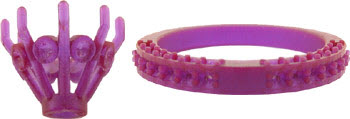What is rhodium plating?
Does white gold discolor or turn yellow over time?
Are all white gold rings rhodium plated?
How much does it cost to rhodium plate a ring?
How long does rhodium plating last?
With the recent popularity of white metals, we are asked similar questions more and more frequently. The answers depends on several factors that I will explain below.
Our current cost as of December 2015 for rhodium plating starts at $53 per piece. This includes cleaning and polishing. To have Knox rhodium plate your jewelry, contact us here.
Rhodium plating or “dipping” is the standard in our industry to make white gold items white. Nearly all white gold jewelry sold in the U.S. market is rhodium plated. All 14k and 18k white golds are alloyed with other white metals to achieve a white look. Given that both of these alloys are predominantly pure yellow gold (14k is 58.5% pure and 18k is 75% pure), the resulting color isn’t absolutely white like platinum. In order to provide a beautiful bleached white color, white gold is plated with a platinum group metal called rhodium. This rhodium plating is a non-permanent metal deposition process that can be done while you wait at most jewelry stores.
The actual layer or coat of rhodium, which is applied in an electroplating process, is microscopic (maybe a few microns thick) and will eventually wear off. Body chemistry, excessive sweat, occupational and lifestyle wear, and chlorine can all shorten the life of rhodium plating. A new rhodium plating should last six months to a year on a ring until the plating will be noticeably diminished. The yellowing of the bottom of the ring is usually the first noticeable sign that your rhodium plating is wearing thin. Areas with diamonds, filigree, or engraving will retain the rhodium finish longer as these areas receive less wear. Also, rings with large polished areas will make the inevitable wearing away of the rhodium finish more noticeable. Rhodium plating on pendants and earrings will last much longer as they aren’t exposed to as much wear and tear or skin oils.
To properly rhodium plate an item, the item should first be polished and then thoroughly cleaned via an ultrasonic bath and a distilled water steaming. It is paramount that it is absolutely free of any dirt, oil, and polishing compound before it is plated. After this cleaning, the item should also go through an electro-cleaning process. This final step will help ensure proper rhodium adhesion as the heated cleaning solution is activated by electricity. If there are yellow or rose gold elements in the jewelry, they will need to be masked with a non-permeable substance (fingernail polish is popular) so those areas are not plated white.
Like anything else, results will vary, especially if shortcuts are taken. If fewer of the above described cleaning steps are used in the process, the rhodium finish could prematurely wear off.
In the last few years rhodium plating has become a more expensive service to provide as rhodium prices have sky-rocketed to $6000.00 per ounce. Expect to pay between $25.00 to $60.00 for a complete polishing, cleaning, and Rhodium plating of a ring. Two tone designs may be more due to the necessity of masking the areas that are not to be plated.









